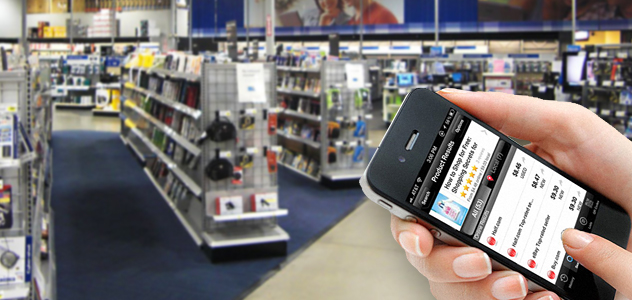
It’s called “showrooming,” and it’s spelling trouble for brick-and-mortar retailers.
If you visited stores on Black Friday you probably saw a lot of people using smartphones. Nothing unusual about that. We’ve become accustomed to seeing people walking in that head-down position – sometimes with calamitous results. It’s likely that many of these holiday shoppers were on a mission. They were showrooming, or extreme shopping as it’s sometimes called. Maybe you’ve done it yourself, gone into a retail location to see and touch and demo a product. Then you consulted the Internet on your smartphone to see if it was cheaper online. Yep, you’re a showroomer.
An Unsurprising Response
The ecommerce community, of course, loves this practice. In some cases they even encourage it. By using Amazon Price Check, for example (iPhone, iPod Touch and Android smartphones), you can type a search term, scan a barcode, snap a photo or simply say the product’s name out loud. The app then displays similar items and the lowest price available.
Amazon Price Check May Be Evil But It’s the Future, a Forbes.com headline proclaimed when the app launched in 2011.
Retailers have been quick to cry foul – and to respond. Target abruptly stopped selling Amazon Kindle products in the spring of 2012. The New York Times confirmed that Target executives had sent a letter to vendors asking them to, “…think of new pricing and inventory strategies.” Best Buy stopped attaching standard bar codes to some of its pricier floor inventory.
Lots of Lookie-Loos
In October 2012, the National Retail Federation reported on a study done by BIGinsight that predicted that slightly more dollars would be spent during the 2012 holiday shopping season. And, it continued, more bargain-hunters than ever would shop online – 51.8 percent, compared to 46.7 percent last year. The report also predicted that more than half of smartphone users would use mobile devices to research products for their holiday needs. That percentage jumped to nearly two-thirds of tablet owners.
Those numbers are less impressive – and undoubtedly less frightening to retail store owners – when you consider that only 15 percent were expected to actually purchase products using smartphones (30 percent for tablets). In fact, Business Insider recently questioned whether these fears were being blown out of proportion. The site quoted Forrester analyst Sucharita Mulpuru, who cited numerous reasons why shoppers will continue to complete purchases in person. “As long as the price is generally comparable among channels, consumers are unlikely to switch to another retailer or channel,” she said.
Beat ‘em or Join ‘em?
Still, brick-and-mortar stores have been getting creative – and more generous — with customer service strategies, as they attempt to offset the showrooming trend. Some stores like Walmart allow shoppers to browse and purchase online and then pick up their items in the store – often on the same day. Many are matching online prices.
So as retailers in the cloud and at the mall compete for dollars, it seems that the real winners are the shoppers.

